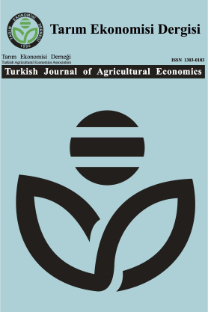Erzurum İlinde Uygulanan Hayvancılığa Yönelik Çiftçi Eğitimi Projelerinin Karşılaştırmalı Analizi
Comperative Analysis of the Farmer Training Projects to Improve Animal Husbandry Implemented in Erzurum
___
Anonim., 2008. Erzurum Büyükbas Hayvan Islahı Projesi, http://www.evbim.gov.tr/EBHIP/dokuman/Proje_Tani mi.doc(22.04. 2008)Bernet, T., Ortiz, O., Estrada, R.D., Quiroz, R., Swinton, S. M., 2001. Tailoring Agriculture Extension to Different Production Contexts: A User-Friendly Farm Household Model to Improve Decision-Making for Participatory Research, Michigan State University, East Lansing, USA.
Boyacı, M., 1998. Tarımsal Bilgi ve Teknoloji Akısı (Enformasyon) Sisteminin Yapısal Özellikleri, Sorunları ve Çözüm Önerileri Üzerine Bir Arastırma: Manisa Ili Örnegi, (Doktora Tezi), Ege Üniversitesi Fen Bilimleri Enstitüsü, Izmir.
BTC., 2008. BTC websitesi , http://www.rsdpinfo.com/trciptr/content/view/20/61/, (20.04.2008).
Çiçek, A., Erkan, O., 1996. Tarım Ekonomisinde Arastırma ve Örnekleme Yöntemleri, Gaziosmanpasa Üniversitesi Ziraat Fakültesi Yayınları No: 12, Ders Notları Serisi No:6,Tokat.
Farrington, J., 2000. The Changing Public Role in Agriculture Extension , Agriculture Research and Extension Network, Overseas Development Institute, Regent's College, Inner Circle, London NW1 4NS, UK.
Hulme, D., 2004. Agricultural Extension: Public Service or Private Business?, Administrative College of Papua New Guinea . PO Box 1216, Boroko, Papua New Guinea.
Oktay, E., Boyacı, M., Karaturhan, B., Bayaner, A., Sakarya, H., 1995. Bilgi ve Teknoloji Akısında Etkinligin Saglanması, Türkiye Ziraat Mühendisligi Teknik Kongresi.Ankara.
Olgun, A., 1994. 2000'li Yıllara Girerken Tarımsal Yayımdan Beklentiler, Türkiye I. Tarım Ekonomisi Kongresi, Izmir.
Özkaya, T., Ceylan, C., Aktas, Y., Selli, F., Pekizoglu, F., 2005. Tarımsal Yayım Hizmetleri ve Organizasyonu, Türkiye Ziraat MühendisligiTeknik Kongresi,Ankara.
Yavuz, F., 2007. Erzurum Ili Büyükbas Hayvan Islahı Projesi Çiftçi El Kitabı, Erzurum.
Yavuz, F., Atsan, T., 2003. Türkiye Tarımsal Egitim, Arastırma ve Yayım Sisteminin ABD ve AB ile Mukayesesi, Tarım ve Köyisleri Bakanlıgı Türktarım Dergisi,Ankara.
Yavuz, F., 1997. ABD “Land-Grant” Üniversitelerinde Tarımsal Egitimi Arastırma ve Yayım Sistemi, Atatürk Üniversitesi Ziraat FakültesiYayınları, Erzurum.
Yurttas, Z., Yavuz, F., Atsan, T., 2000. Tarımsal Egitim, Arastırma ve Yayım Faaliyetleri Arasındaki Iliskilerin Organizasyonu Üzerine Bir Çalısma: Dünyadaki Durum ve Türkiye ile Karsılastırılması, IV. Ulusal Tarım Ekonomisi Kongresi,Tekirdag.
Yurttas, Z., 1979. Tarımsal Yayım Yönünden Bir Köy Incelemesi ve Program Degerlendirmesi Üzerine Bir Arastırma, (Yayınlanmamıs Doçentlik Tezi), Atatürk Üniversitesi Ziraat Fakültesi Tarım Ekonomisi Bölümü, Erzurum.
Wadsworth, J., 2003. Developing Efficient Extension Strategies: Results of an Experiment Involving Costa Rican Livestock Producers. Department of Agriculture and Horticulture, University of Reading, Reading RG6 2AP, UK.
- ISSN: 1303-0183
- Yayın Aralığı: 2
- Başlangıç: 1992
- Yayıncı: Tarım Ekonomisi Dergisi
Erzurum İlinde Uygulanan Hayvancılığa Yönelik Çiftçi Eğitimi Projelerinin Karşılaştırmalı Analizi
Ayşe SEZGİN, Ziya YURTTAŞ, Fahri YAVUZ
Türkiye'de Önemli Gıda Ürünlerinin Talep Esneklikleri
CUMA AKBAY, ABDULBAKİ BİLGİÇ, Bülent MİRAN
Ziraat Eğitiminde Başarıya Etki Eden Faktörlerin Analizi: Atatürk Üniversitesi Örneği
Gap Projesi'nin Türkiye'nin Kırsal Kalkınma Politikaları İçindeki Yeri ve Önemi
Erzurum İli Pasinler İlçesinde Ayçiçeği Üretimi Yapan İşletmelerin Sermaye Yapısı
Tuğba Erem KAYA, Semiha KIZILOGLU
ERTUĞRUL GÜREŞCİ, Ziya YURTTAŞ
GAP Bölgesi'nde Kaliteli İçme Suyunun Fiyatlandırılmasına Etki Eden Faktörler
Güneş EREN, Abdulbaki BİLGİÇ, BAHRİ KARLI, Bülent MİRAN
Hayvancılık İşletmelerinin Avrupa Birliğine Uyumu ve Rekabet Edebilirliği; Doğu Anadolu Örneği
TÜRKİYE ŞEKER SEKTÖRÜNDE ÖZELLEŞTİRME SÜRECİNDE ÖRGÜTSEL SAPMALAR
